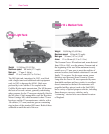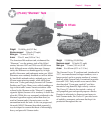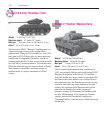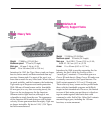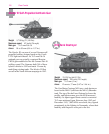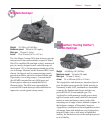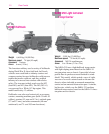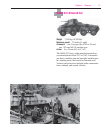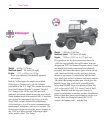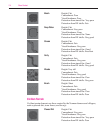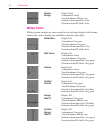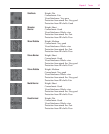
112
Close Combat
Jeep
Kfz 1
Kübelwagen
Weight
986 kg (2,170 lbs)
Maximum speed
80 km/h (50 mph)
Engine
1,131 cc (69 cu. in.) 25 hp
4-cyl (rear-mounted, horizontally opposed,
air-cooled)
Built by Volkswagen, the simple and reliable
Kübelwagen (“bucket car”) was the German
equivalent of the U.S. Jeep. This nimble four-seater,
based on Ferdinand Porsche’s original “People’s
Car” design of the 1930s, used the same rear-
mounted, air-cooled engine driving the rear wheels.
Some standard models mounted an MG 42 machine
gun, giving the innocuous Kübelwagen a deadly
sting. Other variants included the amphibious
Schwimmwagen, as well as radio communications,
maintenance, ambulance, and survey versions. The
Kübelwagen design survived the war to reappear in
the 1970s as a Mexican-built Volkswagen sport-
utility model called “The Thing.”
Weight
1,090 kg (2,400 lbs)
Maximum speed
105 km/h (65 mph)
Engine
2,200 cc (134.2 cu. in.) 72 hp 4-cyl
First produced for the American armed forces in
1940, the Jeep probably derived its name from the
designation “GP” for General Purpose vehicle. Small
and nimble but stoutly constructed and relatively
powerful, this four-wheel-drive open vehicle served
with American, British, and Soviet forces in every
theater of operations. It could haul a half-ton load
over nearly any surface or terrain, and many carried a
.50-caliber Browning machine gun, which gave the
humble Jeep a long reach and a powerful punch.
More than 650,000 Jeeps were produced from July
1941 to the end of 1945. U.S. Army Chief of Staff
George Marshall said the Jeep was America’s
greatest contribution to modern warfare; Eisenhower
believed that three basic tools helped to win the war
for the Allies: the Douglas Dakota (DC3/C47)
aircraft, the landing craft—and the Jeep.



